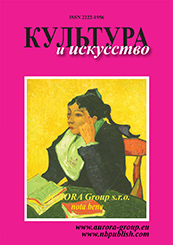Music and music culture
Reference:
LI, L. (2025). The embodiment of Chinese poetry in the cycle "Songs of a Traveler" by G. Sviridov. Culture and Art, 4, 1–17. https://doi.org/10.7256/2454-0625.2025.4.73568
Abstract:
The subject of the study is the vocal cycle "Songs of the Wayfarer" by G.V. Sviridov, set to poems by Chinese poets translated by Yu.K. Shchutsky. The significance of this work extends far beyond a simple reference to Eastern poetry. The article examines the characteristics of the musical embodiment of Chinese poetry in the vocal cycle "Songs of the Wayfarer" by G.V. Sviridov. Taking the song "Return to the Homeland" as an example, a detailed analysis is conducted of the musical and expressive means employed by the composer to convey poetic imagery. Special attention is given to the texture, harmony, and form, as well as the methods of creating a synthesis of Russian musical tradition and Chinese poetic imagery. The role of the piano accompaniment in creating an artistic whole is investigated. Characteristic features of Sviridov's late style are identified in the context of intercultural dialogue. The research is based on a comprehensive approach that includes historical and cultural, textual, and musicological analysis. Methods of comparative analysis, structural-functional analysis, and semantic interpretation of the musical text are applied. The scientific novelty of the study lies in the identification of unique mechanisms for the transformation of Chinese poetic imagery within the context of Russian musical tradition. For the first time, specific techniques that allowed Sviridov to achieve an organic synthesis of Eastern poetic contemplation and Western compositional technique are analyzed in detail. The conclusions of the study demonstrate that the great Soviet and Russian composer Georgy Vasilyevich Sviridov created an original musical language, avoiding direct quotation or superficial stylization of Chinese music. The cycle features a special type of melody that combines the lyrical quality of Russian romance with the conciseness of Eastern poetry, a carefully thought-out textural dramaturgy, flexible metrorhythmic organization, and a particular approach to timbre. The significance of the work transcends the realm of experimentation in intercultural dialogue, touching upon universal themes of human existence.
Keywords:
musical form, Songs of a Wanderer, style, Melody line, piano accompaniment, intercultural dialogue, musical analysis, vocal cycle, Chinese poetry, Georgy Sviridov
Culture and authority
Reference:
Petrov, N.P. (2025). The influence of Soviet cultural policy on the formation of the genre structure of animated films. Culture and Art, 4, 18–25. https://doi.org/10.7256/2454-0625.2025.4.74210
Abstract:
The article examines the impact of Soviet cultural policy on the evolution of the genre system of animated cinema from 1953 to 1991. The relevance of the study is determined by the need for a comprehensive analysis of the mechanisms of direct and indirect influence of state ideology on the artistic features of animation, which played a defining role in shaping the cultural landscape of the era. The subject of the research is the relationship between Soviet cultural policy and the genre development of domestic animation. The main attention is focused on a detailed analysis of the phased transformation of genre models, the fundamental changes in visual-narrative strategies, and the complex dialectical relationship between ideological demands and the creative search of authors. The work systematically conducts a scientific periodization of the development of genres and meticulously investigates the stable correlation between a radical change in political courses and the subsequent modification of plot structures. The article employs comparative methods, historical content analysis, as well as the method of systematization and synthesis of data, which allowed for an objective assessment of the influence of state ideology on the genre structure of animated films. Special attention is given to the systematization of genres by time periods and the transformation of plot schemes under the influence of political settings. The goal of the work is to determine the role of state cultural policy in shaping the genre diversity of Soviet animation. The conclusions presented expand the understanding of the relationship between ideology and the artistic language of animation. The research demonstrates how state initiatives stimulated the development of certain genres (such as educational and propagandistic) while limiting others. The novelty of the study lies in its approach, which combines historical content analysis and comparative methods to consider animation as a mirror of the cultural-political processes of the Soviet era. The materials of the article may be useful to specialists in film studies, cultural studies, and the history of animation, as well as to anyone interested in the mechanisms of interaction between art and power in the USSR.
Keywords:
domestic cinema, visual techniques, experimental animation, author's animation, socialist realism, ideology, cultural policy, genre structure, animation, Soviet culture
Gender studies
Reference:
Liu, T. (2025). The Other in the Buddhist Niche: The Formation and Disappearance of the Female Image in the Longmen Grotto Temples. Culture and Art, 4, 26–43. https://doi.org/10.7256/2454-0625.2025.4.74217
Abstract:
This study examines the complex visual and spatial mechanisms of female representation in Chinese Buddhist cave art, with a particular focus on the Longmen Grottoes. As sacred architectural complexes, Buddhist caves are not only repositories of devotional images but also gendered spaces in which hierarchical social structures and religious forms of subjectivity are encoded. Women frequently appear in these visual programs—primarily in the role of donor figures—but their depiction is typically marked by marginal spatial placement, reduced scale, and stereotypical facial and bodily features. These visual strategies simultaneously render women visible and push them to a symbolic periphery, creating a dual process of representation and erasure. This research centers on the representation of women in Chinese Buddhist cave art, addressing a cutting-edge topic at the intersection of religious art and gender studies. The article engages in a comprehensive discussion of the mechanisms through which gender and power interact in Buddhist iconography. It combines the theory of alterity with the practice of Buddhist visual language to move beyond the traditional, simplified depiction of donor figures. The argument is presented through feminist critique and image analysis. Against the backdrop of a growing re-evaluation of female spiritual subjectivity and the increasing study of women's positions within non-Western visual traditions, this work offers a Chinese perspective on how women construct spaces of agency within traditional religious and patriarchal structures. It also contributes a cultural perspective to contemporary discussions on gender equality and religious diversity. The aim of this research is to analyze the visual representation of women in Chinese Buddhist art, with a special emphasis on cave art—particularly the Longmen Grottoes. The study seeks to explore how gender and power interact in Buddhist iconography and how female figures express their spiritual practices and subjectivity while situated within religious and social structures.
Keywords:
Feminine representation, Patronage, Religious space, Visual subjectivity, Iconography, Gender and religion, Female patron, Longmen Grottoes, Buddhist cave art, Otherness
 This work is licensed under a Creative Commons Attribution-NonCommercial 4.0 International License.
This work is licensed under a Creative Commons Attribution-NonCommercial 4.0 International License.










 © 1998 – 2025 Nota Bene. Publishing Technologies. NB-Media Ltd.
© 1998 – 2025 Nota Bene. Publishing Technologies. NB-Media Ltd.




